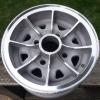I bought this cam 2 years ago to be honest, and I didn't have a real clue about camshaft designs, or I wouldve bought a 'tamer' cam 
WHen I put a timing disc on the cam itself ( no crankshaft in the engine yet, that'll be for tomorrow) the inlet valve is opened for around 210° on the camshaft itself. Could thsi be realistic? Or should I try measuring it in a different way?
cheers
Zero the wheel at TDC, both valves will be open, if you turn the crank backward and detect where the inlet opens, it will point between 30-35 degs on the wheel.
Now crank it, the wheel will go past the 0 and the 180 marks then the inlet closes with the wheel showing around 110 degs, you can do the math now.
Thats what i'd expect from a 288 degs cam.
Most standard road cams are between 230 and 250 degs, at 210 it will be way too short.
I would modify this and say: turn the crank backwards past where the inlet opens, then turn it forwards to where the inlet opens (to eliminate chain slack error) and note that number.
I would actually suggest a further modification and move the degree wheel from the Cam to the Crank Nose.
Who puts a degree wheel on the cam? Actually if you had one divided into 720 degrees, it's arguably less susceptible to measurement error because it has twice the resolution for a given diameter. It could also act as a measurement of actual chain slack error referenced against another one on the crank.
















